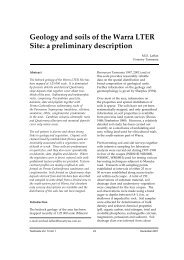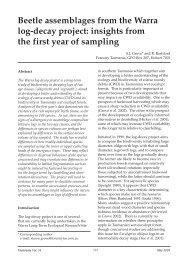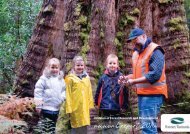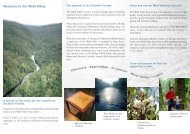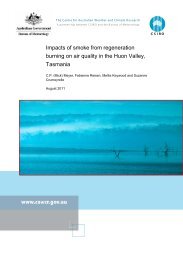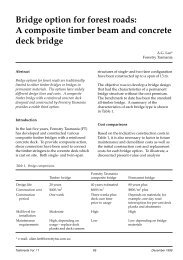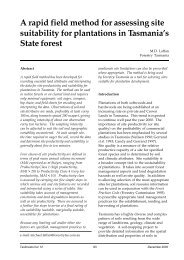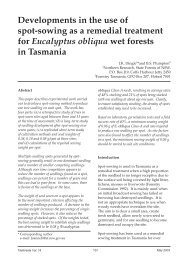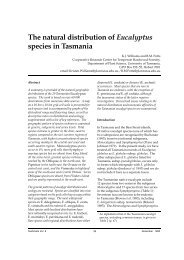sustainable forest management - Forestry Tasmania
sustainable forest management - Forestry Tasmania
sustainable forest management - Forestry Tasmania
Create successful ePaper yourself
Turn your PDF publications into a flip-book with our unique Google optimized e-Paper software.
Case Study - Biodiversity responses to alternative<br />
silvicultural treatments<br />
<strong>Forestry</strong> <strong>Tasmania</strong> established the Warra Silvicultural<br />
Systems Trial (SST) in 1998 to compare clearfelling with<br />
alternative treatments in wet eucalypt <strong>forest</strong> (Figure 1).<br />
Following clearfelling on 80-100 year rotations, the <strong>forest</strong><br />
may not provide suitable habitat for species that either<br />
prefer or rely on much older <strong>forest</strong>, e.g. rain<strong>forest</strong> trees or<br />
birds and mammals that nest in tree hollows. An important<br />
objective for an alternative harvesting system is to be<br />
able to maintain and/or more rapidly regain mature <strong>forest</strong><br />
biodiversity elements compared to clearfelling.<br />
A series of long-term studies was established in the Warra<br />
SST to monitor the responses of important types of <strong>forest</strong><br />
biodiversity to alternative silvicultural systems. Systems<br />
assessed were: unlogged control (CON), aggregated<br />
retention (ARN) where approximately 30 per cent of the<br />
coupe area was retained in 0.5 - 1 hectare aggregates;<br />
dispersed retention (DRN) where 10 per cent of overstorey<br />
eucalypt basal area was retained scattered throughout<br />
the coupe ; and clearfell, burn and sow with 20 x 40 metre<br />
understorey islands (CBS ± UI). Although a recent wildfire<br />
would be the ideal control for such research, no appropriate<br />
sites were available.<br />
The three-year post harvest sampling has recently been<br />
completed for vascular plants, mosses, lichens, birds,<br />
beetles and habitat trees. These biodiversity studies found<br />
that alternative silvicultural systems were advantageous<br />
for many mature <strong>forest</strong> biodiversity elements. Aggregated<br />
retention was more effective than dispersed retention or<br />
clearfelling with understorey islands at maintaining mature<br />
<strong>forest</strong> species and structures in the coupes for the first three<br />
years following harvesting.<br />
These findings support <strong>Forestry</strong> <strong>Tasmania</strong>’s choice of<br />
aggregated retention as a suitable harvesting system<br />
to replace clearfelling in many areas of wet oldgrowth<br />
<strong>forest</strong>. Scientists from <strong>Forestry</strong> <strong>Tasmania</strong>, The University of<br />
<strong>Tasmania</strong>, The <strong>Tasmania</strong>n Herbarium and Forest Practices<br />
Authority have participated in this collaborative project.<br />
Read more about Warra research at:<br />
www.warra.com<br />
Figure 1. Aerial overview of the Warra SST showing layout of treatment coupes in the trial area (ARN<br />
=aggregated retention, CBS-UI =clearfell, burn and sow with understorey islands, CON =unharvested control,<br />
DRN = dispersed retention, GS =group selection, SGS =single tree/small group selection, Strips =Stripfells)<br />
11




